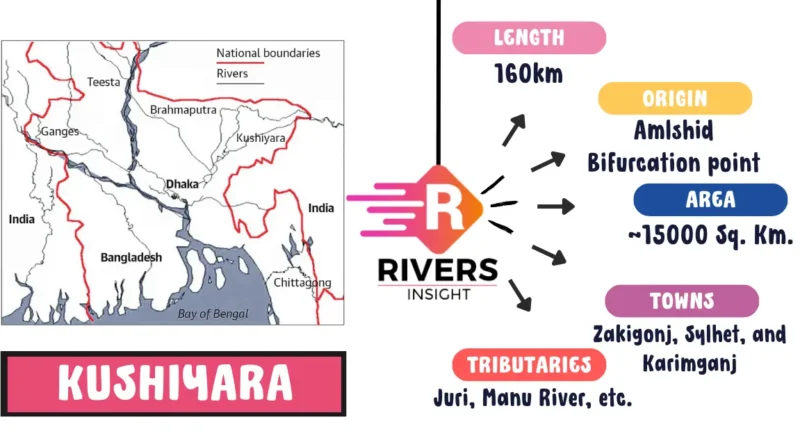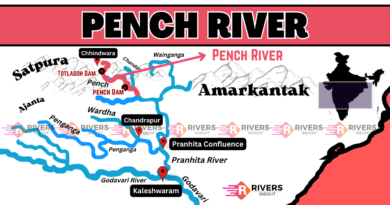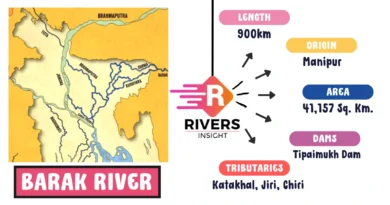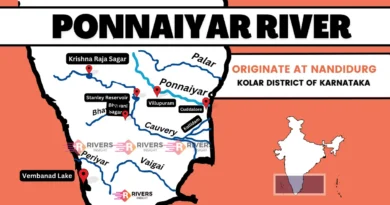Kushiyara River: Origin & Tributaries with Map
The Kushiyara River traverses Bangladesh and Assam, India, and is a distributary of the Barak River. It starts at the border between Bangladesh and India and flows westward, providing the area with an essential supply of water. The river- may seem almost empty in some places during the dry season, notably south of Ajmiriganj Bazar, yet it can reach depths of up to 10 meters during the wet season.
This article will cover the Kushiyara River’s geographical features, including its course, tributaries, and surrounding landscapes. Moreover, we will also talk about recent events, such as the interim water-sharing agreement between Bangladesh and India in 2022, to understand the complexity of managing transboundary rivers.
| River | Kushiyara |
| Length | 160 km |
| Boundary | Assam and Bangladesh |
| Origin | Amlshid bifurcation point |
Table of Contents
Geographical Features of Kushiyara River
The Kushiyara River boasts diverse geographical features that shape its course and influence its significance in the region.
1. Origin
The Kushiyara River originates at the India-Bangladesh border as a branch of the Barak River, known as the Amlshid bifurcation point. It begins its journey westward, serving as a vital water source for the surrounding areas.
2. Course
Flowing westward, the River forms the boundary between Assam, India, and the Sylhet District of Bangladesh. Along its course, it passes through towns like Zakigonj, Sylhet, and Karimganj, Assam, before entering entirely into the Beanibazar Upazila of Bangladesh. The river then meanders southwestward, passing several villages and eventually joining the Meghna River north of Bhairab Bazar.
3. Length
The Kushiyara River spans approximately 160 kilometers from its origin at the Barak River mouth to its confluence with the Meghna River.
4. Tributaries
The Kushiyara River receives contributions from various significant tributaries, including:
- Juri River (from the east)
- Manu River (Monu River) (from the south)
- Itakhola River These tributaries play a crucial role in maintaining the flow and ecological balance of the main river.
Read more: Minor Rivers
Kushiyara River Water Agreement
On September 6, 2022, India and Bangladesh signed the Kushiyara River Water Agreement, which represents a critical turning point in their water-sharing relationship. This treaty, which emphasizes the value of collaboration in the management of shared water resources, is the first significant agreement since the Ganga Water Pact in 1996.
For the first time in twelve years, the India-Bangladesh Joint River Commission met in New Delhi and decided on several important projects. A major resource for both India and Bangladesh, the Kushiyara River is a distributary of the Barak River, which originates in the Assamese uplands and flows through both countries.
The Surma-Meghna River System includes the Barak River, which has its source in Manipur and contributes to the Kushiyara’s flow. By addressing their respective water needs, the pact seeks to benefit Bangladesh’s Sylhet region and southern Assam, India.
As per the agreement, Bangladesh will have the capacity to extract 153 cusecs (cubic feet per second) of water from the Kushiyara during the winter season. The total amount of water accessible in the river is roughly 2,500 cusecs. This water will be efficiently used for irrigation and other uses by being routed through the Rahimpur Canal project in Sylhet.
All things considered, the water deal for the Kushiyara River represents a dedication to collaboration and mutual gain, setting the stage for long-term water management and building goodwill between Bangladesh and India.
Thank You!




